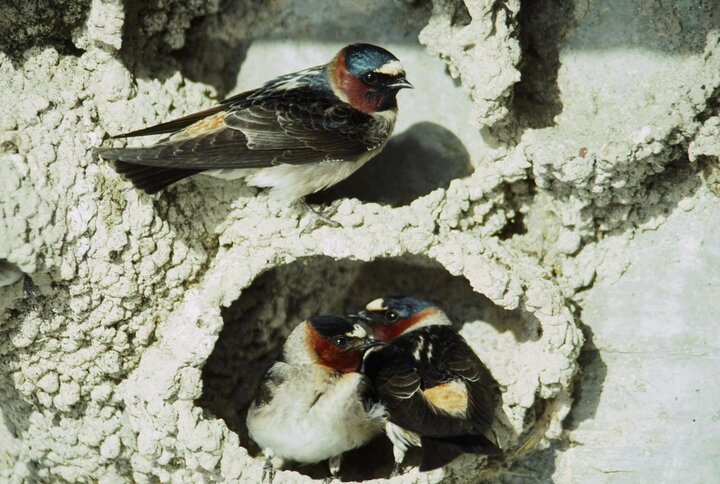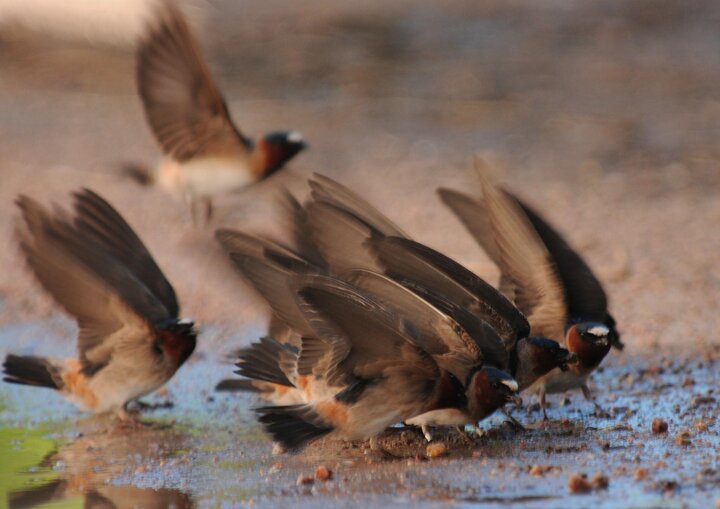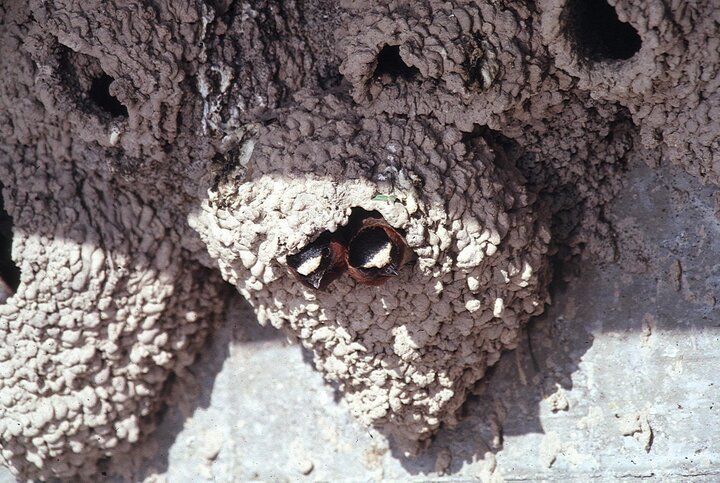What do Cliff Swallows look like?
Cliff Swallows measure 14 mm (5.5 inches) from the tip of their bill to the tip of their tail with 105-110 mm (4-4.5 inch) long wings and adults weigh 22-25 grams (about 1 ounce). They are distinguished from all other birds by having an orange rump patch, triangular white forehead patch, dark blue back, brown-black wings and tail, white belly, and chestnut throat. Males and females look alike throughout the year –there is no sexual dimorphism in their appearance.

What do Cliff Swallows eat?

Cliff Swallows are aerial insectivores which means they only feed on insects they capture in flight. They forage (feed) in flocks of tens to hundreds of individuals and capture insects they find from near ground level to as much as 50 meters or more above the ground. They nearly always feed on aggregating species of insects—species that form swarms, mass emergences, are caught in rising thermals or shelter out of the wind on the lee side of structures. They eat grasshoppers, various sorts of flies, plant hoppers, midges, beetles and bugs. Cliff Swallows use social foraging and local enhancement to exchange information on the location of their insect prey. This helps them track the location of the insects so they can feed as efficiently as possible-- very important when they are feeding chicks in their nests. Cliff Swallows even have a special food call vocalization they use during bad weather they use to ‘announce’ where food is to be found. Cliff Swallows drink while in flight by skimming over a lake or river and dipping in their lower mandible to scoop up water.
How long do Cliff Swallows live?
If a Cliff Swallow survives its first fall migration-winter-spring migration cycle–a perilous time for all birds–they may live as long as 13 years, but most probably live only 4 to 6 years.

What are Cliff Swallows’ conservation status?
The International Union for Conservation of Nature (IUCN) considers Cliff Swallows to be a species of Least Concern.
Are Cliff Swallows the swallows of the famous Mission San Juan Capistrano legend?
Yes, according to legend, Cliff Swallows return to the mission in southern California on 19 March (St. Joseph's Day), spend the summer nesting at the mission, and leave for South America on 23 October (Day of San Juan).
References
Brown, C.R. and M. Bomberger Brown. 1995. Cliff Swallow (Hirundo [Petrochelidon] pyrrhonota). In: The Birds of North America, No 149 (A. Poole and F. Gill, eds.). The Academy of Natural Sciences, Philadelphia and The American Ornithologists’ Union, Washington, D.C.
Brown, C.R. and M. Bomberger Brown. 1996. Coloniality in the Cliff Swallow: the Effect of Group Size on Social Behavior. University of Chicago Press, Chicago, IL
Cliff Swallow (Petrochelidon pyrrhonota). Cornell Lab of Ornithology, https://www.allaboutbirds.org/guide/Cliff_Swallow/id